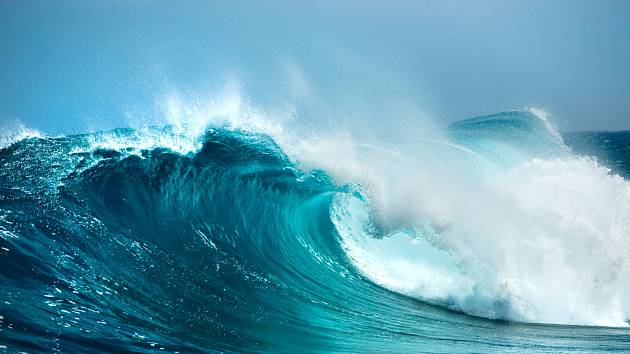- An unexpected phenomenon scared scientists: The surface of the ocean suddenly warmed to a record temperature
- Temperature differences are record high
- A surprising reason
- Ocean warming is just the beginning. Scientists are also afraid of El Niño
- El Niño will increase the risk of extreme weather
- The world is warming in leaps and bounds
An unexpected phenomenon scared scientists: The surface of the ocean suddenly warmed to a record temperature
The global ocean level reached a new record temperature this month. This is the first time experts have seen such a large and rapid growth. They don’t yet fully understand why temperatures are rising. But they fear that combined with the coming El Niño, global temperatures could reach new alarming levels by the end of next year.

Click to enlarge
The world’s ocean level reached a new record temperature this April. This is the first time experts have seen such a large and rapid growth
| Photo: Shutterstock
Scientists are puzzling over why the water in the last month in the oceans heats to high temperatures. In addition, they are also troubled by their assumption that the meteorological phenomenon El Niño will occur in the coming months, as a result of which the water temperature will also rise.
Warmer oceans are a problem for Earth. Experts fear for the future of some underwater animals, raising the water level and also reducing the efficiency of water in absorbing greenhouse gases.
Last week, oceanographer Karina Von Schuckmann and her team published a study in which they draw attention to a disturbing development. The results of their research, published in the scientific journal Earth System Science Data, show that in the last 15 years almost as much heat has accumulated on Earth as in the previous 45 years. Most of the additional energy ended up in the oceans.
Temperature differences are record high
This is where scientists see a problem. The fact that most of the heat went into the oceans has real consequences. Not only did the overall temperature reach a new record this April, but in some areas the difference from the long-standing state was really huge, the BBC writes.
In March, for example, the sea surface temperature off the east coast of North America was 13.8 degrees Celsius higher than the 1981-2011 average. “It is not yet clearly established why such a rapid and huge change is occurring,” said Von Schuckmann, who is a member of the research group Mercator Ocean International.
What would Earth look like if all the glaciers melted:
In the last 15 years, humans have doubled the heat in the climate system, according to the oceanographer. “I don’t want to say that it’s climate change, or natural climate volatility, or a mixture of both, we don’t know yet. But what we see is this change,” she added.
A surprising reason
Paradoxically, one of the factors that could influence the level of heat reaching the oceans is the reduction of emissions from shipping.
In 2020, the International Maritime Organization introduced regulations to reduce the sulfur content of fuel used by ships. The new regulation had a quick effect and the amount of aerosol particles that had been released by ships into the air until then was reduced.
However, this led to an interesting effect. Although the aerosol polluted the air, it also effectively helped reflect heat back into space. With its decline, more heat began to reach the Earth and the oceans, according to experts.
The average surface temperature of the world’s seas has increased by approximately 0.9 degrees Celsius compared to pre-industrial times. At the same time, it has increased by 0.6 degrees over the last 40 years.
These are smaller numbers than the increase in air temperature over land, which has increased by more than 1.5 degrees Celsius since pre-industrial times. This is because it takes much more energy to heat water than to heat land. In addition, oceans absorb heat deep below their surface.
Even such a seemingly small average increase has big real-world consequences. One of the most significant is the fact that more frequent and intense heat waves in the seas lead to mass deaths of marine animals. Coral reefs are particularly sensitive, for which an increase of only 1 degree Celsius is enough to cause death.
Increased heat at the top of the ocean surface also means hurricanes and cyclones can pick up more energy. As a result, they are more intense and last longer. In addition, warmer water takes up more space due to thermal expansion and melts the glaciers of Greenland and Antarctica more easily due to its influence. This increases the level even more and at the same time increases the risk of coastal flooding.
Another impact of warmer seas is a reduction in the water’s ability to absorb carbon dioxide. Currently, the oceans absorb approximately a quarter of greenhouse gas emissions. However, if they absorb less CO2 in the future, more of it would therefore accumulate in the atmosphere. This would then lead to another atmospheric warming and water
Ocean warming is just the beginning. Scientists are also afraid of El Niño
Experts are also concerned about the meteorological phenomenon known as El Niño – Southern Oscillation. For the past three years, this naturally occurring phenomenon has been in a cooler phase called La Niña, helping to keep global temperatures in check.
El Niño:
However, scientists now believe that a strong El Niño is forming, which will have major consequences for the world. “The Australian Bureau’s model has been predicting a strong El Niño for a long time. All the climate models show that this is a stronger phenomenon,” said Hugh McDowell from the Australian Bureau of Meteorology.
El Niño will increase the risk of extreme weather
A coastal El Niño has already formed off the coasts of Peru and Ecuador. Experts believe it will soon be followed by a fully formed phenomenon. “If we add another El Niño to that, there will probably be another one global warming by 0.2 to 0.25 degrees Celsius,” said Josef Ludescher from the Potsdam Institute for Climate Research.
According to him, the year 2024 will therefore be the warmest in history. “Maybe we’ll get closer to 1.5 degrees Celsius. We may even exceed it temporarily,” added Ludescher.
Scientists fear several problems as a result of El Niño. They fear the phenomenon is likely to disrupt weather patterns around the world, weakening monsoons while increasing the risk of bushfires in Australia.
Another concern is that as more heat enters the ocean, the water is slowly losing its ability to store excess energy. There are also concerns that the heat contained in the oceans will not remain in them.
The BBC contacted several experts to comment on the situation. Most of them were reluctant to comment on the consequences of El Niño. “I’m extremely worried and absolutely stressed,” said one off the record.
The world is warming in leaps and bounds
Some research shows that the world is warming in bursts, where little changes over the years, followed by sudden jumps up like taking two flights of stairs. According to scientists, these jumps are closely related to the development of El Niño.
According to Von Schuckmann, there is some hope in this scenario. Temperatures could drop again after El Niño wears off, she said. “We still have room to act and we should use it to mitigate the consequences,” she added.







